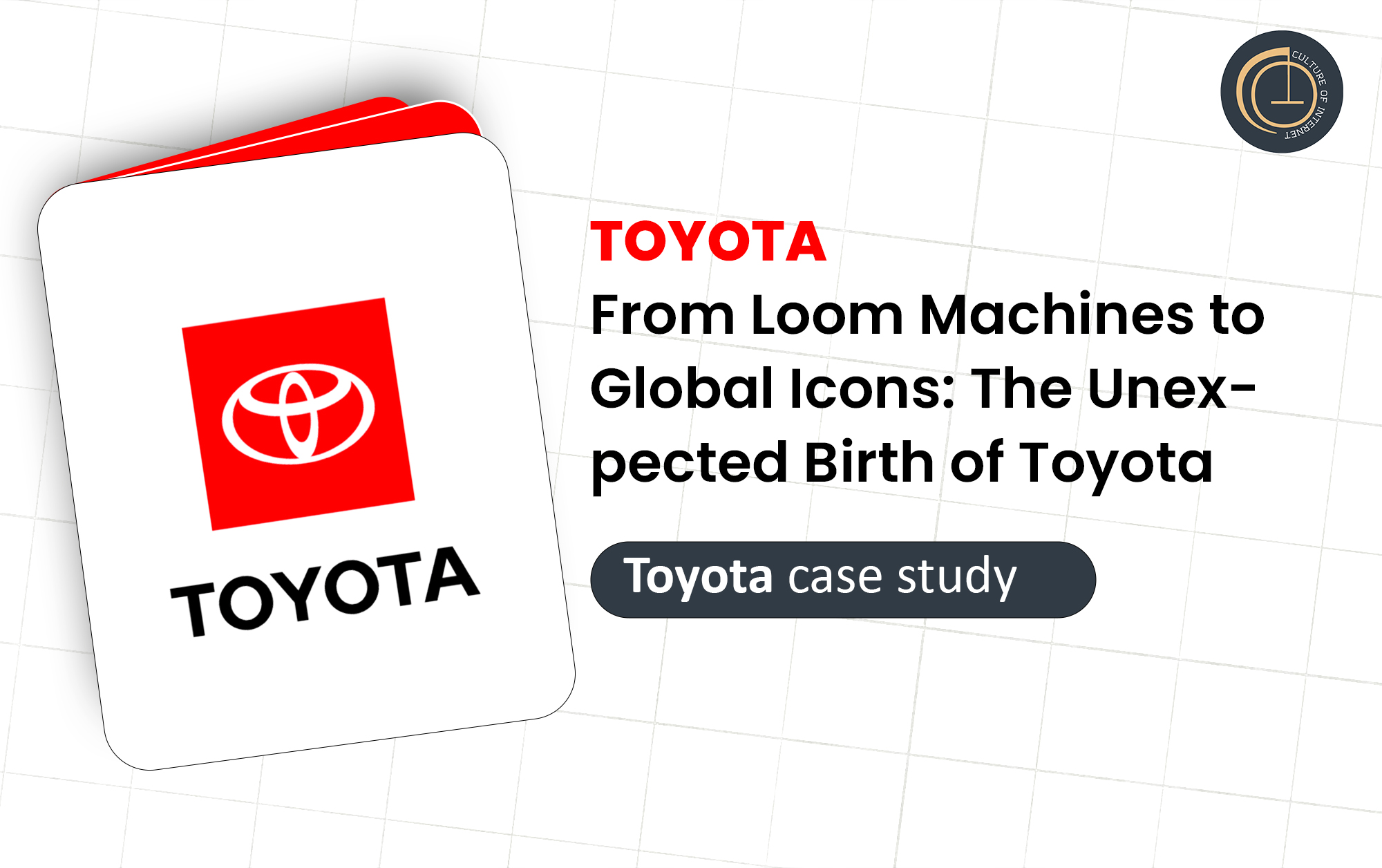Toyota: Company Overview
From Loom Machines to Global Icons: The Unexpected Birth of Toyota
Alright, buckle up because this one’s wild. Long before Toyota was the global car giant it is today, it was making… looms. Yep — those machines that weave fabric. Back in 1926, a genius named Sakichi Toyoda built these automatic looms that were so good, they could basically run by themselves. And when he sold the patent to a British company, his son Kiichiro Toyoda decided to use the cash for something totally different: cars. In a Japan where people barely owned cars, this was borderline madness. But by 1937, Toyota Motor Corporation was born, and there was no turning back.
And here’s a fun fact — the family changed the spelling from "Toyoda" to "Toyota" because it took eight brush strokes to write in Japanese, a lucky number symbolizing prosperity. Told you this was a Netflix-worthy story.
How Toyota Quietly Took Over the World While Everyone Was Flexing
While other car companies were busy showing off muscle cars and chrome grills, Toyota was quietly building cars that just wouldn’t die. One by one, countries started noticing these affordable, reliable rides. By 2025, Toyota was selling in 170+ countries, with over 366,000 employees and moving more than 10 million vehicles a year. That’s one car sold every three seconds. No cap.
They didn’t do it with noise or drama. They simply made cars people trusted. When folks saw their neighbor’s Corolla still kicking after 20 years with only minor scratches and a working AC, they wanted in. Word of mouth built Toyota’s empire.
Why Your Dad’s Old Corolla Is Still Running (And Probably Will Forever)
What makes Toyota so untouchable? In a word: reliability. Thanks to their legendary Toyota Production System (TPS), they made quality a religion. Their factories swear by Kaizen — which means continuous improvement. And it shows. You’ll find 20-year-old Corollas still cruising Indian streets and old Land Cruisers ruling African deserts like they own the place.
And it’s not just mechanical durability. Toyota parts are everywhere, so maintenance is a breeze. Even in remote towns, someone will have that exact spare part you need. That’s power.
Toyota’s Story Is So Dramatic, It Could Be a Netflix Series
Toyota’s journey wasn’t some fairy tale. After WWII, they were flat broke. Then they dared to enter the US market in the ’50s, where American carmakers laughed them off. Fast forward to the 1970s oil crisis and suddenly, those tiny fuel-efficient Toyotas were everyone’s new best friend.
Then in the '80s, they dropped Lexus — a luxury division meant to challenge Mercedes and BMW — and blew everyone’s minds. And don’t forget the Prius in 1997 — the first mass-produced hybrid that made eco-friendly driving a thing. It wasn’t just a car, it was a cultural moment.
Achievements? They’d Need a Trophy Room Bigger Than a Football Stadium
-
Corolla: Best-selling car ever — over 50 million units.
-
Prius: Made hybrid cars cool before it was trendy
-
First with hydrogen fuel cell vehicles.
-
Multiple World Car of the Year awards.
-
Consistently one of the world’s most valuable brands.
-
First to introduce lean manufacturing globally.
-
First Japanese automaker to build factories in the US.
The Kind of Stats That’ll Make Even Tesla Nervous
| Year | Global Sales (Million) | Revenue (USD Billion) | Net Profit (USD Billion) |
|---|---|---|---|
| 2021 | 10.5 | 276.6 | 20.8 |
| 2022 | 10.38 | 275.3 | 19.8 |
| 2023 | 11.1 | 296.1 | 23.1 |
| 2024 | 11.6 | 310.5 | 24.5 |
Steady growth like this isn’t luck. It’s decades of smart moves.
This Ain’t Just a Car Company — It’s a Global Movement
Toyota runs more than 60 plants in 27 countries. They’ve got supply chains and networks so huge, they practically run mini economies. And with partnerships in everything from energy to AI, Toyota’s influence reaches way beyond the road.
Their biggest strength? They build cars tailored to local markets. Compact hatchbacks for India. Massive trucks for the US. Hybrids for Europe. They never slap one size fits all. It’s why they’ve stayed ahead.
Toyota’s Secret Recipe for World Domination (Hint: No Hype Needed)
Their game plan is simple but deadly effective:
-
Kaizen: Daily improvements.
-
Toyota Production System: Lean, efficient, zero-waste.
-
Global Localization: Build local, sell local.
-
Future Focus: Always bet on tomorrow’s tech.
-
Keep It Real: Make cars people actually need.
And the secret sauce? Patience. They don’t chase trends for quick clout. They invest slow, perfect their tech, then dominate.
The Crazy Collabs You’d Never Guess Toyota Pulled Off
-
BMW: Supra and Z4.
-
Subaru: Toyota 86 and BRZ.
-
Panasonic: EV batteries.
-
Mazda: Joint EV factories.
-
Uber & Didi: Ride-hailing and autonomous tech.
-
Tesla: Early partnership for electric vehicle parts.
-
Yamaha: Racing engine collaborations.
Savage Acquisitions That Made Toyota Way Too Powerful
Toyota doesn’t acquire for headlines — they do it for strategy:
-
Daihatsu: Compact car kings.
-
Hino Motors: Truck and bus beasts.
-
Central Motors: Specialist manufacturer.
-
Toyota Boshoku: Interiors and car parts.
-
Investments in ride-hailing giants like Grab and Uber.
The Playbook That Turned a Small Japanese Company Into a Global Monster
-
Make stuff that lasts.
-
Stay humble.
-
Fix mistakes fast.
-
Innovate where it matters.
-
Grow slow, but steady.
-
Build strong local partnerships.
-
Bet on tech before it’s trendy.
Yeah, They Messed Up Too — And Here’s How They Fixed It Like Bosses
Remember the 2010 acceleration crisis? 8 million cars recalled. It hurt. But Toyota owned up, fixed their systems, and came back swinging. COVID, chip shortages, and EV delays? Same story. They tightened their supply chains, doubled down on tech, and started making moves in EVs like bZ (Beyond Zero).
And now, they’re pushing hydrogen cars, autonomous driving, and solid-state batteries like it’s nobody’s business.
Bouncing Back Stronger: Toyota’s ‘Don’t Cry, Work Harder’ Attitude
They didn’t tweet excuses or blame markets. They worked harder. Invested smarter. Learned faster. They doubled down on R&D, started localizing even more, and quietly became one of the few automakers with real options in hybrid, hydrogen, and electric tech.
Why Toyota’s Social Media Game Is Low-Key Brilliant
While others chase viral trends, Toyota focuses on relevance. Smart local campaigns, powerful Olympics ads like “Start Your Impossible,” and subtle digital dominance.
Their India campaigns during Diwali, their eco-friendly challenges in Europe, and their adventure-packed 4x4 content for Australia are lessons in knowing your audience.
Digital Stats That’ll Make You Go, ‘Wait, They Did That?’
| Platform | Followers (2024) | Engagement |
|---|---|---|
| 5.2M | 3.4% | |
| YouTube | 3.8M | 4.1% |
| 4.5M | 2.9% | |
| 1.3M | 2.5% | |
| 2.1M | 3.0% |
Not flashy — just effective. Solid engagement, meaningful content, and no desperate viral chases.
Final Take: Toyota Isn’t a Brand, It’s a Way of Life
Here’s the thing: Toyota didn’t build its empire on flexing or hype. It did it by making cars people could count on, by improving a little every day, and by betting on the future without losing sight of the basics. It’s not just a car company. It’s a culture, a mindset, a movement.
When your granddad drove a Corolla, your dad bought an Innova, and you dream of a Land Cruiser — you realize Toyota isn’t just a product. It’s a generational legacy. And the best part? This story’s nowhere near done.
Explore Our Comprehensive Marketing Strategy Course
Join our in-depth course to master Toyota India's marketing strategies, learn from expert case studies, and gain actionable insights to apply in your own business or career.









